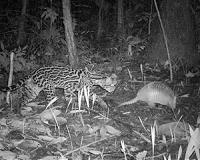| . |  |
. |
New Delhi (AFP) March 2, 2011 One of India's foremost conservationists, who devoted his life to saving the country's dwindling tiger population, has died aged 73 after a two-month battle with cancer. Fateh Singh Rathore, known as the "Tiger Man" and often pictured in a safari hat with his characteristic handlebar moustache, passed away on Monday near the wildlife sanctuary in the western state of Rajasthan that he helped create. The Ranthambore tiger reserve, set up in 1973, is his greatest legacy after more than 40 years campaigning for India's Big Cat, whose numbers have shrunk dramatically from 40,000 in 1947 to about 1,400 today. A vocal critic of India's conservation policies, Rathore made enemies in the local government but earned a devoted following in wildlife circles. "He was a visionary," an emotional Belinda Wright, executive director of the Wildlife Protection Society of India, told AFP on Wednesday. "He created a tiger sanctuary in Ranthambore at a time when there were so few tigers there by persuading villagers to move out and clear the land so the tigers would come back. And they did," she said. His determination and concern earned him visits from several dignitaries, including the late Indian prime minister Rajiv Gandhi and then-US President Bill Clinton, who travelled to Ranthambore in 2000. "I remember meeting a beaming Clinton soon after he had met Fateh Singh and I knew from the smile on his face that he had just had the 'Fateh Singh Rathore' experience," one of his proteges, Valmik Thapar, told AFP. "No one could enjoy life the way he did and mingle easily with everyone from a villager to a president," added Thapar, who is a leading tiger conservationist and filmmaker. The Ranthambore reserve today attracts 60,000 tourists every year, drawn to its populations of leopards, tigers and other rare wildlife that survive in the vast and arid expanse in east Rajasthan. Rathore, who was posted to the Ranthambore hills area in 1971, described moving villagers out of the proposed tiger reserve as "one of my most difficult assignments." "The people hugged the trees and wept," he told Sanctuary magazine in 2008. "I was crying with them because inside me I knew they were paying the price for something they may never understand." Rathore began his career in conservation in 1969 with a training programme with the Wildlife Institute of India, a state conservation body, and was posted to Ranthambore when he graduated, working there until 1988. Towards the end of his time there, he sparred with state forestry officers over their conservation policies, angered by the inexorable decline in the numbers of tigers in the wild. In the land that inspired Rudyard Kipling's legendary Jungle Book stories -- featuring the cunning tiger protagonist Shere Khan -- authorities are in danger of losing their battle against poachers and other man-made problems. India is home to more than half of the world's rapidly dwindling wild tigers, but even its conservation programme, said by the government to be the world's most comprehensive, has failed to halt their demise. "The last time I met him, on February 11, he was very frail, but he indicated that he wanted to go to the park," Wright told AFP. "As we drove through, we suddenly saw two tigers, and he was just over the moon."
Share This Article With Planet Earth
Related Links Darwin Today At TerraDaily.com
 Candid Cameras Give A Chance To See Wildlife As A Scientist Does
Candid Cameras Give A Chance To See Wildlife As A Scientist DoesBoston MA (SPX) Feb 28, 2011 The new website allows the public to see exactly what scientists see in their research-photos of wildlife captured at close range, from the head-on stare of a jaguar in Peru to inside the mouth of a giant panda in China. "This site provides the public a glimpse of what the scientist sees when surveying remote places," said William McShea, research wildlife biologist at the Smithsonian Cons ... read more |
|
| The content herein, unless otherwise known to be public domain, are Copyright 1995-2010 - SpaceDaily. AFP and UPI Wire Stories are copyright Agence France-Presse and United Press International. ESA Portal Reports are copyright European Space Agency. All NASA sourced material is public domain. Additional copyrights may apply in whole or part to other bona fide parties. Advertising does not imply endorsement,agreement or approval of any opinions, statements or information provided by SpaceDaily on any Web page published or hosted by SpaceDaily. Privacy Statement |